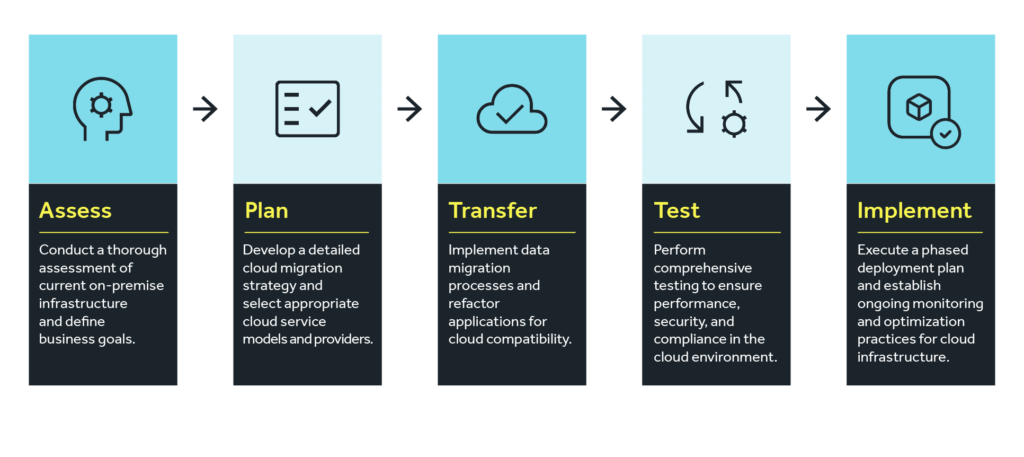
Cloud & Platform Strategy
Innovative cloud and platform services to enhance IT scalability, agility, and security through software
Ensure scalability to handle varying usage demands
Design a self-aware cloud environment that auto-scales resources during peak usage and allows for elastic load balancing
Accelerate dev cycles and decrease time-to-market
Design your infrastructure to accommodate automated testing and monitoring, and automated server provisioning and setup of CI/CD pipelines
Elevate operational responsiveness
Allow for flexible resource allocation, automated traffic management, disaster recovery plan execution, and provisioning.
Overview
Developing a successful cloud and platform strategy can deliver a host of benefits to your business including increased cost savings, decreased time to market, and the ability to instantiate rapid innovation cycles. A successful strategy often requires partnering with experts who can help you craft the right approach and roadmap based on your business goals.
Our Cloud & Platform Strategy services are designed to guide clients through the many factors you need to consider when migrating to the cloud or optimizing your existing cloud infrastructure. Whether it’s calculating the CapEx versus OpEx tradeoff of migrating part of your workload to the cloud or creating business continuity plans for cloud failover, our teams have seen it all and done it all.

Services
Cloud Migration Planning
Strategic cloud migration planning and implementation so you can transition to the cloud with confidence.
Infrastructure as a Services (IaaS)
Pinpoint optimal IaaS resources for development and testing to ensure scalability and flexibility of resources.
Platform as a Service (PaaS)
Identify ways to streamline development and deployment and accelerate innovation with PaaS solutions that remove the need to manage infrastructure.
Software as a Service (SaaS)
Determine advanced software solutions and application services for your product’s cloud and platform management.
Disaster Recovery as a Service (DRaaS)
Establish business continuity and peace of mind by designing in and leveraging cloud services with automated recovery, geographic redundancy, and enhanced security.
Cloud Storage Solutions
Choose scalable and cost-effective storage solutions for your data needs and specific business use cases and considerations.
Cloud Security Services
Secure your cloud data with robust defenses against cyberthreats, Distributed Denial of Service (DDoS) attacks, and advanced solutions for identity and access management, threat detection, and data protection.
Managed Cloud Services
Receive expert management and support for your cloud infrastructure to guarantee availability, cost efficiency, and comprehensive monitoring and reporting.
Factors that influence cloud & platform development costs
There are a broad range of factors and considerations that impact the cost of cloud migrations, cloud computing, and platform development. It’s best to go into any cloud migration or implementation engagement with a full understanding of what drives cost. Our Cloud & Platform Strategy engagement takes the following factors into account when crafting recommendations for you:
Cloud costs are heavily influenced by the amount of compute power, storage, and network bandwidth consumed, with higher usage leading to increased costs.
The type of cloud service model—Infrastructure as a Service (IaaS), Platform as a Service (PaaS), or Software as a Service (SaaS)—affects pricing, with each offering different levels of management and support.
Costs can vary based on the volume of data transferred into and out of the cloud environment, with outbound data transfer typically incurring higher charges.
The location of the data center can impact costs due to differences in regional pricing, infrastructure costs, and data transfer fees.
The ability to automatically scale resources up or down to handle peak demands can influence costs, as provisioning additional resources during high demand periods incurs additional charges.
Implementing redundancy and backup solutions to ensure data protection and disaster recovery can add to the overall cost due to the need for additional storage and resources.
Advanced security features and compliance with industry regulations can increase costs, as they require additional resources and management.
The level of support and managed services required can affect pricing, with higher levels of support and management typically resulting in higher costs.
The use of third-party software and licenses can add to the cost, as these often come with their own pricing structures and fees.
Customizing and integrating cloud services with existing systems can influence costs, depending on the complexity and resources needed to develop and maintain these bespoke solutions.

Maintaining Security in the Cloud
Enhanced Security
Ensuring robust cloud security involves implementing advanced threat detection systems to identify and mitigate potential vulnerabilities in real-time. Regular security updates are essential to protect against emerging threats and to patch any discovered weaknesses, maintaining the integrity and confidentiality of your data.
Compliance and Regulatory Support
Compliance with regulations and standards is a fundamental aspect of maintaining cloud security. Tools designed for GDPR compliance help ensure that personal data is processed in accordance with legal requirements, while industry-specific certifications demonstrate adherence to best practices and security standards.
Disaster Recovery and Business Continuity
A robust disaster recovery and business continuity strategy should include regular cloud backups to ensure data is preserved and can be restored quickly in the event of a breach or failure. Failover solutions are also important to maintain continuous operation by automatically redirecting traffic to a secondary system if the primary one fails.

Assess. Analyze. Strategize.
Develop a cloud and platform strategy that drives agility, innovation, and scalability. Contact us today.
Let’s Talk
